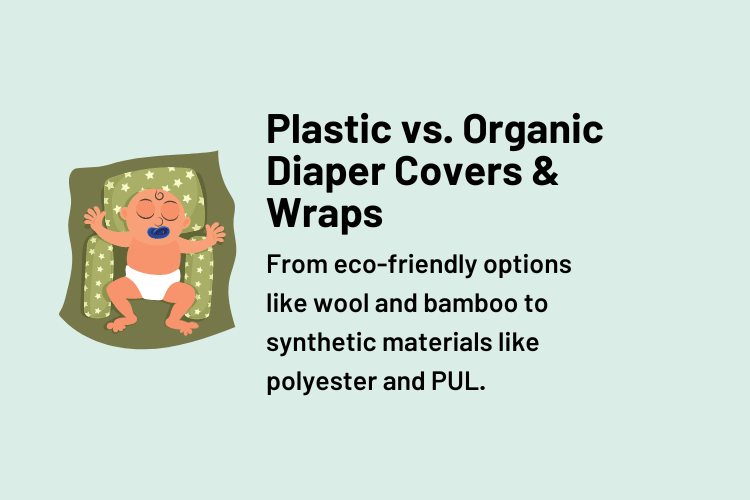
Add some cloth diaper covers to your diaper drawer to make your cloth diapering experience more enjoyable. Diaper covers and wraps provide a barrier between the diaper and baby’s clothing and skin to prevent leakage and dampness from spreading. As with cloth diapers, there’s a great deal of choice when it comes to selecting diaper covers, especially when you consider that many diapers have them built-in. Here are some of the facts you’ll need to know before buying diaper covers and diaper wraps.
This article covers the following:
Bamboo and wool diaper covers
For a natural diaper cover, consider wool or bamboo which come with a variety of benefits for the baby:
- Breathability: Both are extremely breathable, more so than plastics used in many all-in-ones.
- Absorbent: Both materials can hold tremendous quantities of liquid before feeling damp to the touch.
- Comfortable: By and large, good quality wool diaper covers are not scratchy and will fit comfortably beside baby’s skin. Bamboo is incredibly soft and should not pose a problem for any babies with dermal sensitivities.
- Temperature control: Wool will also help to keep baby’s temperature 4°C cooler than synthetic options, which is great for preventing diaper rash and other bacteria problems.
- Odor-resistant: Wool and bamboo have natural anti-bacterial properties, so they won’t suffer from odor problems like other materials will and can be washed approximately every two weeks (air-dried in between wearings).
- Care: It is recommended that you use a special wool wash when you launder wool covers, and add lanolin every 10-12 washes to maintain water resistance. Bamboo can be cared for like cotton.
Unfortunately, much of the wool on the market today is produced using conventional cultivation methods, which are cruel for sheep and not so healthy for the planet. Sheep are traditionally sprayed with chemicals to prevent pests (which may be unhealthy for your baby) and can be subjected to inhumane treatment during their lives and transport. To avoid these problems, look for organic diaper covers made from Certified Organic wool or organic cotton products.
Polyester and fleece diaper wraps
Polyester and fleece diaper covers work well if organic wool or bamboo diaper covers won’t work for you. Polyester is good for many reasons:
- Breathability: Polyester breathes relatively well and will wick moisture away from baby’s skin which helps to prevent rashes.
- Comfort: Both polyester and fleece are generally made with soft outer layers for a comfortable fit for the baby.
- Waterproof: Polyester is waterproof, making it a great barrier against leaks.
- Care: You may have to wash these more often than wool covers, but they don’t require special detergents or care.
In today’s world, there are some novel degradable polyesters at our disposal. Therefore, it´s essential to examine the specific type of plastic being utilized and its degradation process.
Not so eco-friendly diaper covers and wraps
Polyurethane laminate (PUL) diaper covers
PUL is a fabric treatment that has gained popularity in recent years. It can be applied to porous fabrics like polyester and cotton to provide a waterproof layer. It is a highly flexible product but keeps moisture from passing through, making it a fairly good option for cloth diaper covers.
Unfortunately, one of the precursors of polyurethane is toluene 2,4-diisocyanate (TDI), a potent carcinogen. Though it may not pose a direct threat to your baby, it will enter the environment during the manufacturing of this product, making it less than green.
Polyvinyl chloride (PVC) diaper wraps
A few of the all-in-one cloth diaper makers and some of the cloth diaper cover brands are made with polyvinyl chloride (PVC). This material contaminates the environment with dioxins (persistent chemicals that can cause cancer as well as other human health problems) throughout its lifecycle.
Not only that but PVC is made using phthalates, a class of plasticizers that make plastics soft, of which bisphenol A (BPA) is the most well-known. Phthalates have been linked to many health and environmental problems, including reproductive system disruption, as well as kidney, lung, and liver problems. As such, Ecolife doesn’t recommend any cloth diaper accessories, including covers, made from PVC.
Caring for your diaper covers
As you can see, there are many types of materials to consider when buying diaper covers. The methods you use to care for them will therefore be determined by the type of material you select. Check with your manufacturer to get their specific recommendations for how often to use diaper covers before they are laundered, and how to clean them when the time comes.
